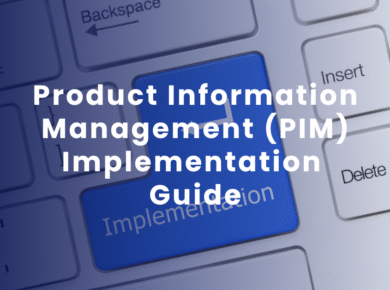How Will GenAI Redefine the Hybrid Shopper Experience? Read Blog Holiday shopping
From Static to Smart: The Shift in Data Management
Data management is undergoing a fundamental transformation—shifting from static, rule-based processes to intelligent, adaptive systems fueled by Generative AI. This change is not just technical; it’s strategic, enabling organizations to respond faster to market shifts, customer expectations, and internal demands. Within this evolving landscape, platforms like Product Information Management (PIM) and Master Data Management (MDM) are being reimagined. No longer limited to storing and standardizing data, they are becoming proactive engines that interpret, enrich, and deliver high-quality data across channels in real time.
Rethinking Product Data in the Age of AI
Product data is no longer just information stored in spreadsheets or backend systems—it’s become a dynamic asset. As we move deeper into 2025, businesses are increasingly adopting AI-first strategies to handle product information. This shift is more than a technological upgrade; it represents a fundamental change in how data is generated, organized, and delivered across digital ecosystems.
With Generative AI (GenAI) at the center, companies are moving away from rule-bound processes toward intelligent automation that adapts and learns in real time. As a result, traditional roles of Product Information Management (PIM) and Master Data Management (MDM) are being reshaped.
What Does ‘AI-First’ Really Mean?
An AI-first approach means that artificial intelligence is not just an add-on—it is embedded in the architecture and workflows from the start. In the context of product data, this includes automated content creation, real-time data enrichment, personalized outputs, and adaptive governance.
Rather than relying solely on structured templates and human input, these systems continuously learn from patterns, user behavior, and contextual cues. This allows for faster decisions, consistent data quality, and more meaningful customer interactions.
How GenAI Is Elevating Product Information Management (PIM) Platforms?
PIM systems have traditionally focused on maintaining clean and complete product records. But in today’s landscape, that alone isn’t enough. Businesses need to publish content faster, in multiple languages, across dozens of channels, while keeping everything aligned with brand voice and legal standards.
This is where GenAI becomes a game changer.
With AI, product descriptions, feature sets, and promotional content can be created at scale—automatically. These outputs don’t just check boxes; they reflect tone, audience preferences, and marketing strategies. AI-generated content is now capable of mimicking human-like creativity and precision, helping teams reduce manual workloads while improving quality and speed.
Even more, AI can recognize how different attributes relate to each other. For instance, it understands that a waterproof feature may be associated with outdoor use, enabling smarter metadata tagging and recommendation logic.
Going Global with Localized Precision
For global organizations, localization is often a costly and time-intensive task. Translating and adapting product content for different regions, cultures, and languages has historically required a vast amount of human effort.
AI-first platforms simplify this process by using contextual understanding to produce localized content that resonates. These systems aren’t just translating—they’re tailoring descriptions, legal text, and feature highlights based on local norms, regulatory frameworks, and user expectations.
In parallel, AI ensures that product data aligns with platform-specific standards. These adjustments happen automatically, reducing errors and accelerating channel readiness.
Master Data Management (MDM) Is Becoming Smarter—and More Predictive
The evolution of master data management (MDM) is just as critical. Instead of acting as a passive repository of records, AI-enhanced MDM solutions now actively identify discrepancies, detect patterns, and recommend corrections.
By learning from past data behavior, these systems can resolve duplicate entries, unify multi-source datasets, and suggest accurate attribute mappings—all with minimal manual input. This ‘self-healing’ capability helps businesses maintain a high level of trust in their core data, which is essential for every downstream application.
The implications are significant, especially for enterprises operating across multiple business units, geographies, and digital platforms. AI-powered MDM ensures that data flowing into ERP, CRM, eCommerce, and analytics systems remains consistent and actionable.
Distribution in Real Time with Enterprise-Grade Controls
Getting product data out into the world used to mean long approval cycles and slow content updates. Now, AI-first platforms distribute data to digital channels in near real time, optimizing the format, language, and tone depending on the destination.
But speed doesn’t come at the cost of oversight. Generative AI also plays a role in enforcing compliance and brand governance. It checks whether mandatory fields are present, validates regional legal requirements, and ensures that the voice and tone match brand guidelines. This reduces regulatory risks and protects brand reputation at scale.
From Static Product Data to Engaging Product Experiences
Customer expectations have shifted. Buyers, whether B2B or B2C, now expect relevant, personalized experiences across every interaction. Product data plays a crucial role in delivering those experiences—but only if it’s timely, enriched, and contextually relevant.
AI helps connect product data with behavioral signals—what the customer has searched for, clicked on, or purchased before. With this insight, companies can serve more meaningful content: think tailored recommendations, dynamic filters, or content variations based on geography or device.
What once required complex personalization engines and dedicated teams can now be handled by AI that learns and adapts continuously, delivering better outcomes with fewer resources.
Building Scalable Infrastructure for a Composable Future
Today’s businesses need systems that can grow and evolve without disruption. The AI-first approach supports this need by embracing composability—a design philosophy where software components are modular, API-friendly, and easy to reconfigure.
Modern PIM and MDM platforms built on this architecture can integrate effortlessly with cloud-based services, enterprise applications, and digital commerce platforms. Whether you’re launching new products, entering new markets, or expanding your digital stack, AI-first systems give you the flexibility and scalability to adapt quickly.
This infrastructure is especially vital for organizations with complex catalogs, frequent data updates, or a global presence. It enables real-time updates, localized rollouts, and agile workflows without heavy IT overhead.
Strategic Takeaways for Technology Leaders
The adoption of AI-first product data management is not just a technical upgrade—it’s a strategic move. For CIOs, CTOs, and IT decision-makers, this transformation represents an opportunity to align data operations with business goals.
By embracing GenAI in PIM and MDM, organizations can:
- Launch products faster and more efficiently
- Deliver consistent, high-quality experiences across channels
- Minimize manual errors and reduce data maintenance costs
- Build a future-ready data infrastructure that can support ongoing innovation
Leaders who prioritize intelligent, scalable, and AI-native systems will be best positioned to respond to market demands, consumer behavior shifts, and operational complexities with speed and confidence.
Conclusion: Turning Product Data into a Strategic Asset
Product data is no longer just about what you sell—it’s about how effectively you deliver that information to the right audience, in the right format, at the right time. AI-first systems, powered by GenAI, turn this vision into reality. By integrating intelligence directly into the structure and delivery of product information, businesses can unlock new efficiencies, improve customer engagement, and gain a distinct competitive edge. The future of product data is adaptive, intelligent, and customer-driven. And it’s already here.
Ready to unlock smarter data experiences with AI-driven PIM and MDM? Contact us to get started.
Latest Resources
How Unified Data Can Keep You Ahead This Holiday Read Blog As
Enterprise Data Management in Transition: 2026 Trends and AI-Driven Shifts Read Blog
Unlocking Growth: Why PIM DAM Integration Is a Strategic Imperative Read Blog
Mastering Product Data Syndication: A Business-Centric Approach Read Blog Why Accurate Product
The Hidden Costs of Missing Metadata in Digital Asset Management Read Blog
Key Takeaways: Identify the Right Time for PIM: Gain clarity on identifying
PIM vs MDM: What’s the Difference and When to Use Each? Read
Questions to Ask When Choosing a PIM Vendor? - Part 2 Read
Questions to Ask When Choosing a PIM Vendor? - Part 1 Read









